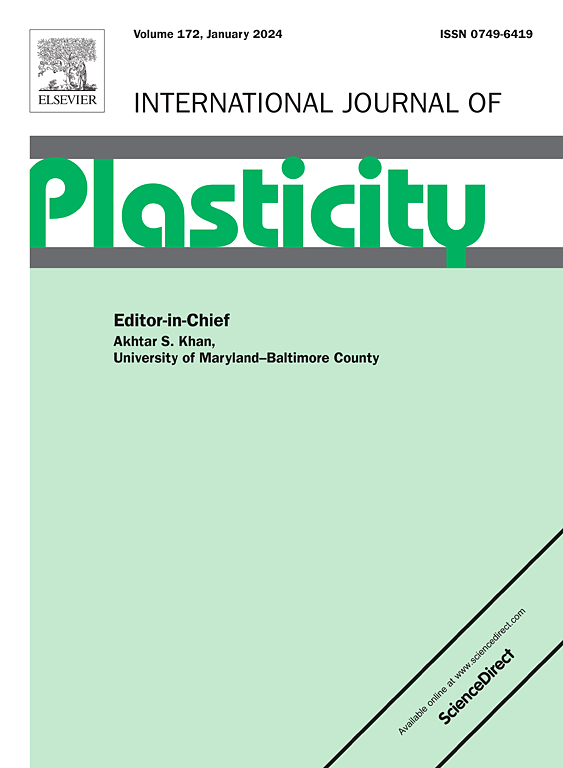结合速率相关晶体塑性的热力学一致损伤演化模型:在不同应变速率下的高强度低合金钢的应用
IF 9.4
1区 材料科学
Q1 ENGINEERING, MECHANICAL
引用次数: 0
摘要
与传统的普通碳钢相比,高强度低合金(HSLA)钢具有优越的强度和承载能力。然而,即使在中等应变速率下,这些钢也容易受到微结构损伤,这可能会影响其在汽车应用中的性能。本研究旨在研究准静态和中等应变速率下HSLA钢的应力应变响应、内部温升和损伤演变。利用电子背散射衍射(EBSD)对HR340和HR550两种不同等级的HSLA钢的初始组织进行了表征。在不同应变速率下的单轴拉伸试验中,利用高速红外热像仪捕捉试样规范截面内瞬时表面温度的上升。提出了一种新的、热力学一致的速率相关晶体塑性公式。损伤演化是由热力学驱动力控制的,热力学驱动力考虑了各种影响(即温度、空洞成核和空洞生长)。为了考虑应变速率和内部温升对损伤演化的影响,提出了一种基于幂律的损伤公式。将本构模型转化为晶体塑性(CP)模型,研究了损伤、温度和织构演化对HSLA钢局部变形的影响。利用实验应力-应变数据和不同应变速率下的温度演化测量数据对本构模型进行了标定。新模型不仅准确地预测了HR340和HR550的软化/后颈缩行为和失效,而且准确地捕捉了材料的温度变化,与实验结果吻合得很好。该模型预测的织构演化与实验观察的不同应变速率下的织构演化结果吻合较好。研究结果表明,应变速率和内部温升对HSLA钢的损伤、位错密度演变和显微组织行为有显著影响。该模型为未来的调查研究奠定了坚实的物理基础。本文章由计算机程序翻译,如有差异,请以英文原文为准。
Thermodynamically consistent damage evolution model coupled with rate-dependent crystal plasticity: Application to high-strength low alloy steel at various strain rates
High-strength low-alloy (HSLA) steels demonstrate superior strength and load-bearing capacity compared to traditional plain carbon steel. However, these steels are susceptible to microstructural damage even at intermediate strain rates, which can compromise their performance in automotive application. This research aims to investigate the stress-strain response, internal temperature rise, and damage evolution in HSLA steels under quasi-static and intermediate strain rates. The initial microstructure of two different grades of HSLA steels, HR340 and HR550, are characterized using Electron Backscatter Diffraction (EBSD) data. During uniaxial tensile tests at various strain rates, a high-speed infrared thermal camera is utilized to capture the rise of the instantaneous surface temperature within the gauge section of the specimens. A new, thermodynamically consistent rate-dependent crystal plasticity formulation is developed. The damage evolution is governed by a thermodynamic driving force that accounts for various effects (i.e., temperature, void nucleation, and void growth). A power-law based damage formulation is proposed to account for the effects of strain rates and internal temperature rise on the damage evolution. The constitutive model is implemented into a crystal plasticity (CP) formulation to study the effects of damage, temperature and texture evolution on localized deformation in HSLA steel. The constitutive model is calibrated using experimental stress-strain data and temperature evolution measurements at different strain rates. The new model not only accurately predicts the softening/post-necking behaviour and failure of HR340 and HR550 but also accurately captures temperature variations in the material, aligning well with experimental results. The texture evolution prediction by the developed model also demonstrated good agreement with experimentally observed texture evolution at different strain rates. This study highlights the significant influence of strain rate and internal temperature rise on the damage, dislocation density evolution and microstructural behavior of HSLA steels. The model serves as a robust physics-based foundation for future investigative studies.
求助全文
通过发布文献求助,成功后即可免费获取论文全文。
去求助
来源期刊

International Journal of Plasticity
工程技术-材料科学:综合
CiteScore
15.30
自引率
26.50%
发文量
256
审稿时长
46 days
期刊介绍:
International Journal of Plasticity aims to present original research encompassing all facets of plastic deformation, damage, and fracture behavior in both isotropic and anisotropic solids. This includes exploring the thermodynamics of plasticity and fracture, continuum theory, and macroscopic as well as microscopic phenomena.
Topics of interest span the plastic behavior of single crystals and polycrystalline metals, ceramics, rocks, soils, composites, nanocrystalline and microelectronics materials, shape memory alloys, ferroelectric ceramics, thin films, and polymers. Additionally, the journal covers plasticity aspects of failure and fracture mechanics. Contributions involving significant experimental, numerical, or theoretical advancements that enhance the understanding of the plastic behavior of solids are particularly valued. Papers addressing the modeling of finite nonlinear elastic deformation, bearing similarities to the modeling of plastic deformation, are also welcomed.
 求助内容:
求助内容: 应助结果提醒方式:
应助结果提醒方式:


